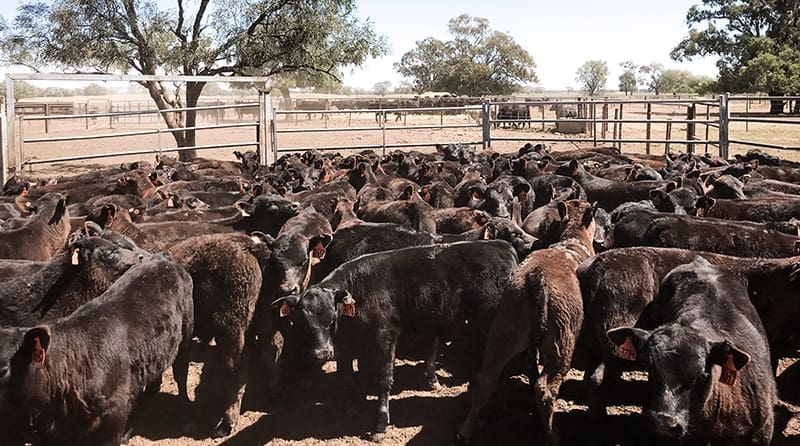
ONE of the traits that beef producers place a high level of importance on when making selection decisions, if not the most important trait, is temperament.
This significance was highlighted in a recent survey of more than 1200 beef producers across Australia which found temperament was the most important trait when selecting replacement bulls.
The temperament of an animal has a big impact on its value within a beef operation and when we talk about temperament, we are talking about the way animals behave when being confined or exposed to usual situations (e.g. being separated from the herd). The benefits of a superior temperament in cattle are well understood and include:
- Lower production costs
- Make cattle easier to muster and handle
- Reduce damage to infrastructure g. yards and fences
- Decrease risk of injury and stress to cattle
- Decrease risk of injury and stress to stock handlers
- Decrease weight loss during transit
- Improve feedlot performance
- Decrease the risk of dark cutters in the It’s estimated that dark cutting beef costs the Australian beef industry in excess of $36 million annually
- Improve eating quality (more tender beef)
For seedstock producers’ temperament is of particular importance due to the significant impact it has on the profitability of their clients’ operations. Importantly temperament is highly heritable and lacks any known antagonistic genetic relationships, meaning we can make improvements in temperament without impacting negatively on other traits within the breeding objective.
Beef producers aiming to improve the genetics of their herd for temperament can achieve this through the implementation of two main selection strategies; culling for poor temperament and selection of sires with superior temperament genetics.
Culling for Poor Temperament
It is common practice for beef breeding enterprises to cull animals from the breeding herd that show unacceptable temperament. This can be done in an “ad-hoc” fashion, where animals are observed and their temperament assessed while being handled, or through the use of a more formal, structured process involving the collection of docility scores.
Docility scores are recorded on animals at weaning or shortly afterwards. The advantage of scoring at weaning is that all calves should have had minimal handling and so will express variation in temperament. Variation in handling between animals prior to scoring should also be minimised.
Docility scores are collected on animals using either a yard or crush test:
- Yard Test – Calves are individually put into a small square yard and the handler attempts to hold the animal in one corner for about 10
- Crush Test – Calves are put up a race and held in a crush or weigh scales for about 10 seconds (but not necessarily head bailed)
This information can not only provide valuable information for the decision to retain an individual but can also feed into the TransTasman Angus Cattle Evaluation (TACE) and contribute to the calculation of EBVs.
Selecting Animals with Superior Temperament
In association with culling, selecting animals that have superior genetics for temperament is paramount to genetically improving this trait in a beef breeding enterprise.
Like other production traits, it is important to select animals for breeding this year that are genetically superior to those used last year. This is particularly important when selecting sires due to their overall influence of the genetics in a herd both short-term and long-term through retained daughters.
The most effective information for selecting animals with superior genetics for temperament are Docility EBVs. Selecting sires with higher Docility EBVs to those used in the previous joining will result in long term genetic improvement.
Docility EBVs provide an estimate of the differences in the percentage of progeny that will have acceptable temperament due to genetics, with higher Docility EBVs indicating an animal is expected to produce relatively more progeny with acceptable temperament.
Calculation of EBVs for temperament has several major advantages over simply considering an animal’s own temperament:
- Like all production traits of economic importance, the observed temperament of an animal is a combination of the genetics inherited from the sire and dam, and the environment and management from which the animal has been run
EBVs for temperament related traits (as with other traits) focus on the genetic differences between animals for temperament by accounting for any environment and management influences.
- EBVs for temperament take into consideration not only the temperament of the individual animal, but also the temperament of all the animal’s In this manner, the EBVs provide a better indication of an animal’s genetics for temperament than an assessment of the animal’s temperament alone.
- EBVs allow for genetic differences in temperament to be identified between animals who themselves may have acceptable temperament. Animals who may have acceptable temperament but are likely to produce a high percentage of progeny with poor temperament can be removed from the breeding herd, or conversely, if two animals of similar genetic merit for other traits are being considered for use within a breeding program, the animal that is likely to produce a higher percentage of progeny with superior temperament can be selected.
Take home messages
- Seedstock breeders should collect docility scores for all calves when collecting their 200 day weights
- Consideration should be given to Docility EBV’s when selecting sires
- Select sires with superior Docility EBVs to those used the year before
Source: Angus Australia


I am apart of the Aistralian South Devon Society. I was wondering if Beef Central would allow us to reproduce this article on temprement for our annual magazine The Review
https://www.beefcentral.com/genetics/genetics-making-gains-with-selection-for-docility/
Full credit will be given to Beef Central
Thanks
Help yourself, James – editor
“No amount of technology (EBVs, Genomics, Phase C tests) can replace astute observation and common sense.”
Johann Zietsman
Very nice article, interesting and important ,
Its an issue not all breeders attribiute enaugh importance